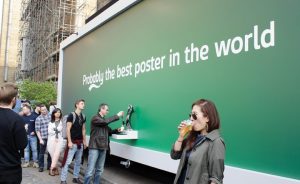In the world of advertising, there are two smaller “divisions” that are typically seen and utilized as totally separate – social (digital) and out-of-home ads. They are often managed by different teams, for different purposes and almost never intertwine.
However, recent technological breakthroughs are making out of home ads more “digital” (DOOH) and a lot more effective at engaging audiences and precise targeting. Coupled with the problem all digital campaigns face – ad blockers that result in 56% of ads never seen by their audiences (according to Google), digital (social media in particular) and physical world ads are starting to unite to reach ultimate marketing goals – extensive reach, deeper engagement and increased return on investment.
Why social makes the perfect company for OOH advertising?
OOH provides increased visibility
A research by Posterscope US has found that using billboards along with a social media campaign can increase reach by up to 203%.
A recent Nielsen research (USA) shows that 46% of adults used search engines to find information after seeing an OOH advertisement, and 38% posted on their Facebook or Instagram.
Digitization of OOH advertising, the spreading of digital advertising panels and use of sophisticated technology for precise targeting of specific audiences in the right location and time of day expand the possibilities of combining social and out-of-home even further.
Social drives deeper audience engagement
Both social media and out of home advertising rely heavily on visuals. Each time consumers come across a funny or creative image or video, they are compelled to share it on their social media accounts. Marketers use this peculiarity in their OOH campaigns to attract mass attention to their ad, and use the potential of social to engage potential customers (it can be as simple as using hashtags or website URLs in the OOH ads).
It can work both ways – starting with out of home media and moving on to social or vice versa.
For instance, Carlsberg’s offline stunt with the poster that serves beer has been very successful in going digital through sharing.

Another example is of Cancer Research UK campaign to raise awareness of their fundraising events, which encouraged their followers on social media to post images using the tag #RaceLace. This was not it – the user images and videos were broadcast live on the 140 digital panels in London Underground, which brought increased attention and social engagement.
It’s @raceforlife #prettymuddy #run day!!! And I got me my #racelace on! 💕#beatcancertogether #cancerresearch pic.twitter.com/TYZ09ARKFl
— Kelly Griffiths (@kellysgriffiths) 14 жовтня 2017 р.
Improved OOH performance through social
By connecting the two channels, advertisers get a great opportunity to evaluate the effectiveness of their creatives intended for offline in social media first, for example, analyzing the number of impressions, click-through rate, and the dwell time.
Moreover, integration of mobile technologies and dynamic delivery of campaigns open up the horizon of effective audience targeting and efficient usage of ad budget.
Data-based content strategy
OOH ad content and messaging can be now tailored for specific locations and audiences with the use of social data, basically enabling brands to speak to consumers in their own language, and use most relevant topics for outstanding results.
Definitely, we live at the time of a new wave of OOH (or rather DOOH) popularity and a totally new level of effectiveness. Don’t miss out on your chance to amplify your social advertising campaign with OOH or digitalize your out of home advertising through social media.
TRACKLAM is right tool to bring together all of your advertising efforts and media, both online and offline, in one interface, and access timely stats from anywhere to make informed decisions and necessary corrections anytime.
Sign up and leverage its potential with no delay!




